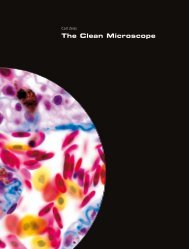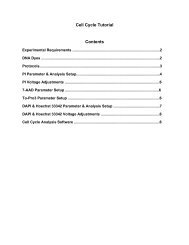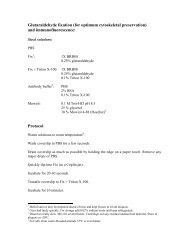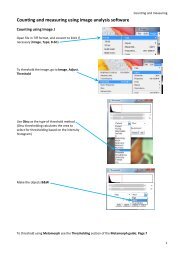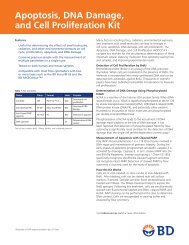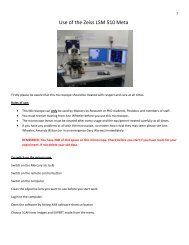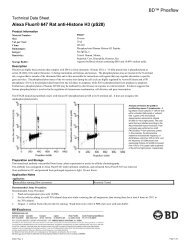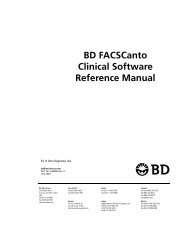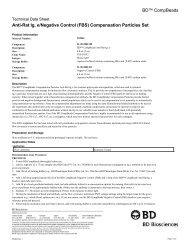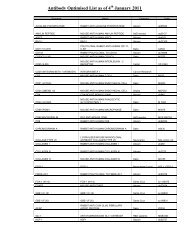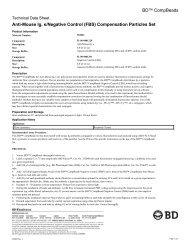Area and Volume estimation on Stereology
Area and Volume estimation on Stereology
Area and Volume estimation on Stereology
You also want an ePaper? Increase the reach of your titles
YUMPU automatically turns print PDFs into web optimized ePapers that Google loves.
Stereological Techniques for<br />
<str<strong>on</strong>g>Area</str<strong>on</strong>g> <str<strong>on</strong>g>and</str<strong>on</strong>g> <str<strong>on</strong>g>Volume</str<strong>on</strong>g> Estimati<strong>on</strong><br />
Susan Hendricks, Ph.D.<br />
Staff Scientist,<br />
All material copyright © 2010 MBF Bioscience – MicroBrightField, Inc.
What to expect in this webinar<br />
• <str<strong>on</strong>g>Area</str<strong>on</strong>g> <str<strong>on</strong>g>and</str<strong>on</strong>g> <str<strong>on</strong>g>Volume</str<strong>on</strong>g> Estimati<strong>on</strong><br />
• Exporting Data <str<strong>on</strong>g>and</str<strong>on</strong>g> Evaluating your data<br />
• Submit questi<strong>on</strong>s within the questi<strong>on</strong> window<br />
• After the webinar… http://forums.mbfbioscience.com<br />
mbfbioscience.com
Balance effort with accuracy<br />
• Design-based stereology is a set of<br />
unbiased methods for quantitative analysis<br />
of the size, shape <str<strong>on</strong>g>and</str<strong>on</strong>g> number of objects.<br />
• The Cavalieri i method is a stereological<br />
l<br />
probe for quantifying regi<strong>on</strong>al volumes.<br />
mbfbioscience.com
Cavalieri Method<br />
Image courtesy of wikipedia<br />
mbfbioscience.com
Calculati<strong>on</strong> of <str<strong>on</strong>g>Volume</str<strong>on</strong>g><br />
<str<strong>on</strong>g>Volume</str<strong>on</strong>g> of the object<br />
is estimated by<br />
summing the areas<br />
<str<strong>on</strong>g>and</str<strong>on</strong>g> multiplying by<br />
the slice thickness.<br />
mbfbioscience.com
Unbiased results require unbiased data<br />
collecti<strong>on</strong><br />
• Anatomical boundaries<br />
• Systematic, R<str<strong>on</strong>g>and</str<strong>on</strong>g>om<br />
Secti<strong>on</strong>s<br />
• Secti<strong>on</strong> Interval<br />
mbfbioscience.com
A grid point represents an area<br />
• Each point<br />
represents a given<br />
area.<br />
• C<strong>on</strong>sistent marking<br />
is critical<br />
mbfbioscience.com
Marking Grid Points<br />
Adapted from Lutz Slomianka’s website: www.lab.anhb.uwa/edu/au<br />
mbfbioscience.com
Unbiased Marking Decisi<strong>on</strong>s<br />
• Examine the boundaries<br />
• Be c<strong>on</strong>sistent!<br />
mbfbioscience.com
Choosing parameters<br />
Striatum <str<strong>on</strong>g>Volume</str<strong>on</strong>g><br />
<str<strong>on</strong>g>Volume</str<strong>on</strong>g> (mm 3 )<br />
Es stimated<br />
15<br />
14<br />
13<br />
12<br />
11<br />
1000 500 400 250 100<br />
Grid Size (m)<br />
mbfbioscience.com
Choosing parameters<br />
Grid Points<br />
5000<br />
<br />
Numbe er of Poin nts<br />
4000<br />
3000<br />
2000<br />
1000<br />
<br />
<br />
0<br />
1000 500 400 250 100<br />
Grid Size<br />
mbfbioscience.com
Accuracy versus Precisi<strong>on</strong><br />
• High Accuracy, Low Precisi<strong>on</strong><br />
• High Precisi<strong>on</strong>, Low Accuracy<br />
• High Precisi<strong>on</strong>, High Accuracy<br />
With sampling, a given estimate of a<br />
populati<strong>on</strong> will vary from the true<br />
number. The goal of stereology is to<br />
ensure that the individual sampling<br />
error does not overshadow the<br />
difference due to experimental<br />
manipulati<strong>on</strong>.<br />
True<br />
number<br />
mbfbioscience.com
Post your questi<strong>on</strong>s now …<br />
A smart experimental design will save<br />
time without sacrificing accuracy.<br />
Questi<strong>on</strong>s<br />
mbfbioscience.com
Example: Cerebellum vs Striatum<br />
• Using a c<strong>on</strong>tour<br />
Advantage:<br />
If you are using<br />
the c<strong>on</strong>tour for<br />
another analysis<br />
Disadvantage:<br />
Tedious if the<br />
regi<strong>on</strong> is<br />
c<strong>on</strong>voluted<br />
mbfbioscience.com
Cavalieri Method in Stereo Investigator ®<br />
• Set up serial secti<strong>on</strong> manager<br />
to organize secti<strong>on</strong>s<br />
• Focus <strong>on</strong> slide or load in<br />
image<br />
• Set Cavalieri grid dimensi<strong>on</strong>s<br />
• Place markers <strong>on</strong> the grid<br />
points that overlay the ROI<br />
mbfbioscience.com
Marking Grid Points<br />
There are 3 ways to mark grid<br />
points:<br />
• Paint markers with <str<strong>on</strong>g>and</str<strong>on</strong>g> without a c<strong>on</strong>tour<br />
• Marquee mode<br />
• Replace mode<br />
Example: Lesi<strong>on</strong> or Tumor studies<br />
• Use 1 marker to paint entire ROI in paint<br />
mode<br />
• Use replace mode to replace the 1st<br />
marker with a 2nd lesi<strong>on</strong>/tumor marker<br />
mbfbioscience.com
Cavalieri Estimati<strong>on</strong> – Painting in C<strong>on</strong>tour<br />
Cavalieri grid spacing: 400 m<br />
<str<strong>on</strong>g>Area</str<strong>on</strong>g> estimate: 2,720,000 m 2<br />
C<strong>on</strong>tour planimetric area: 2,813,630 m 2<br />
mbfbioscience.com
Evaluating Cavalieri Results<br />
• Generate unbiased <str<strong>on</strong>g>estimati<strong>on</strong></str<strong>on</strong>g>s of area <str<strong>on</strong>g>and</str<strong>on</strong>g><br />
volume of all regi<strong>on</strong>s evaluated<br />
• Export results to Excel ® or copy to clipboard<br />
• Gunders<strong>on</strong> Coefficient of Error, m=0 is the<br />
appropriate CE for most applicati<strong>on</strong>s<br />
mbfbioscience.com
Evaluating Cavalieri Results<br />
Data File Marker Estimated <str<strong>on</strong>g>Area</str<strong>on</strong>g><br />
(µm²)<br />
Estimated<br />
<str<strong>on</strong>g>Volume</str<strong>on</strong>g><br />
(mm³)<br />
<str<strong>on</strong>g>Volume</str<strong>on</strong>g> Corrected<br />
for OverProjecti<strong>on</strong><br />
(mm³)<br />
CE<br />
(Gundersen),<br />
m=0<br />
CE<br />
(Gundersen),<br />
m=1<br />
Block<br />
Advance<br />
(µm)<br />
Periodicity Grid Size<br />
(µm)<br />
Secti<strong>on</strong>s Count<br />
C<strong>on</strong>trol 1.ASC Striatum 42187500 12.66 12.20 0.02 0.01 60 5 250 11 675<br />
C<strong>on</strong>trol 2.ASC Striatum 42437500 12.73 12.31 0.02 0.01 60 5 250 11 679<br />
C<strong>on</strong>trol 3.ASC Striatum 43437500 13.03 12.60 002 0.02 001 0.01 60 5 250 11 695<br />
C<strong>on</strong>trol 4.ASC Striatum 39250000 11.78 11.36 0.02 0.01 60 5 250 11 628<br />
C<strong>on</strong>trol 5.ASC Striatum 44562500 13.37 12.93 0.02 0.01 60 5 250 12 713<br />
Experimental1.ASC Striatum 29733300 8.92 8.53 0.02 0.01 60 5 250 12 450<br />
Experimental2.ASC Striatum 24366600 7.31 7.12 0.02 0.01 60 5 250 10 423<br />
Experimental3.ASC Striatum 28566600 8.57 8.12 0.03 0.01 60 5 250 9 441<br />
Experimental4.ASC Striatum 19633300 5.89 5.75 0.02 0.01 60 5 250 11 322<br />
Experimental5.ASC Striatum 20333300 6.10 5.99 0.02 0.01 60 5 250 11 387<br />
• Average volume of c<strong>on</strong>trol ROI = 12.17mm 3<br />
• Average volume of experimental ROI = 7.358mm 3<br />
• Results can be displayed in micr<strong>on</strong>s or millimeters<br />
mbfbioscience.com
Evaluating Cavalieri Results<br />
• Results will list the number of markers placed per<br />
secti<strong>on</strong> for each animal<br />
Number of Cavalie eri Points<br />
200<br />
150<br />
100<br />
50<br />
0<br />
20 30 40 50<br />
Secti<strong>on</strong><br />
mbfbioscience.com
Combining Methods to Create a Story<br />
• Density: express the number of objects<br />
per unit volume<br />
– Measure the volume <str<strong>on</strong>g>and</str<strong>on</strong>g> number<br />
independently so that you know the reas<strong>on</strong><br />
underlying the density change<br />
• Avoid the Reference Trap: volume should<br />
represent the regi<strong>on</strong>, not the populati<strong>on</strong><br />
mbfbioscience.com
C<strong>on</strong>clusi<strong>on</strong><br />
Using Stereo Investigator <str<strong>on</strong>g>and</str<strong>on</strong>g> a smart<br />
experimental design will save you time<br />
without sacrificing accuracy.<br />
Questi<strong>on</strong>s<br />
Visit the Forum!<br />
mbfbioscience.com
mbfbioscience.com





